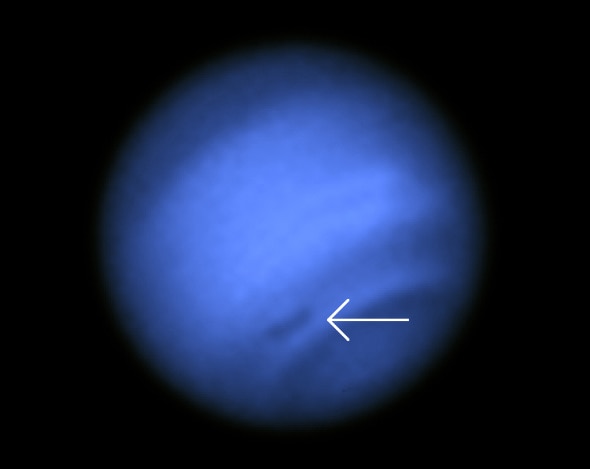Create a free profile to get unlimited access to exclusive videos, sweepstakes, and more!
Neptune Just Got a Little Dark

So Thursday I wrote about Pluto possibly having a liquid water ocean under its surface, which is pretty amazing. But other worlds in the solar system have stuff going on too, y’know.
Like Neptune. It has a new dark spot.
Neptune is what we call an ice giant; bigger than rocky planets like Earth and Mars, but smaller than Jupiter and Saturn. It’s not literally made of frozen stuff; it’s called an ice giant because planetary scientists tend to call things like methane, ammonia, and water ices when dealing with outer worlds.
Neptune orbits pretty far from the Sun, about 4.5 billion kilometers out. That makes it pretty cold, and you might not expect the atmosphere to have much action. For a long time telescopic observations of it didn’t show much (it’s so far away that even though it’s nearly four times wider than Earth, it’s not terribly big in telescopes), but in 1989 the Voyager 2 probe flew past it, revealing a gorgeous deep blue world with a banded atmosphere, and, very surprisingly, a huge dark spot, which was somehow named the Great Dark Spot.
Since then our ‘scopes have gotten better and more of these spots have been found. We now know they’re anticyclones—high pressure systems—in Neptune’s troposphere, the deeper layer of atmosphere under its stratosphere. Since they’re high-pressure systems, we may be peering deeper into Neptune’s atmosphere when we see them.
Dark spots on Neptune tend to be associated with bright clouds around their rims, which may be from methane clouds condensing as air blows around and above the dark spots. This happens on Earth … well, with water instead of methane. Moist air rising up can condense to form clouds; we see this on the windward sides of mountains as the air lifts up to go over the obstacle. In this case, they’re called orographic clouds. With Neptune, the methane freezes, crystallizes, and becomes bright white to form the lovely thin white clouds around the dark spots.
Dark spots come and go. The Great Dark Spot had disappeared by the time Hubble looked for it in 1994, but other ones had appeared in 1995. This new one found is the first one seen in well over a decade. They can last for many years, because they spin in the same direction Neptune does. That sets up a stable feedback system that helps keep the spot rotating (in that case it’s called a vortex). We see this on Jupiter, Saturn, and possibly other places on Neptune, too.
Why is this important? Well, to be frank, atmospheres are complicated. Planets spin, and warm up, and have different stuff in their atmospheres, and sometimes warming or cooling changes the layering and condensation and evaporation rates, and it’s a mess. Understanding them in terms of their physics is really hard.
In some ways the outer planets are simpler than Earth: They’re mostly air. But there are other complications, like gases in abundance we don’t have here (like hydrogen and helium). Also, while the major source of Earth’s heat is the Sun, the outer planets don’t get nearly as much sunlight. Plus, they still have lots of warmth leftover from their formations (yes, they’re still cooling after 4.56 billion years), and for Neptune that’s its major source of heat. So it’s warmed from the inside out, the opposite of Earth.
All these worlds are test cases for our understanding of how atmospheres behave, including our own. Plus, of course, just understanding things is good. Neptune is a huge, massive, complex world, and worthy of our attention just because it exists and is near enough for us to study it.


























